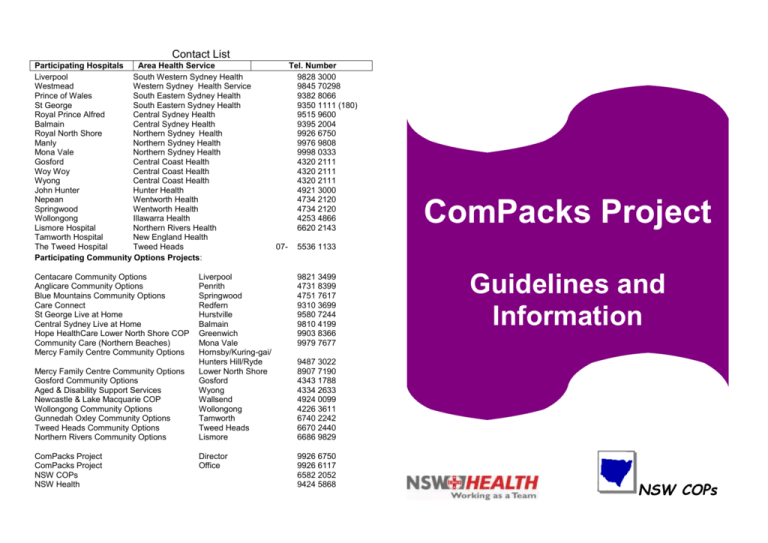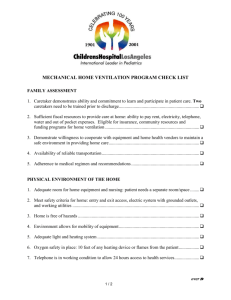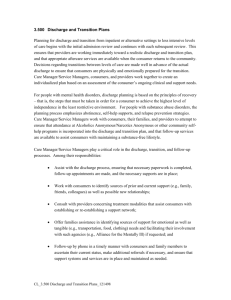What is ComPacks
advertisement

Contact List Participating Hospitals Area Health Service Liverpool South Western Sydney Health Westmead Western Sydney Health Service Prince of Wales South Eastern Sydney Health St George South Eastern Sydney Health Royal Prince Alfred Central Sydney Health Balmain Central Sydney Health Royal North Shore Northern Sydney Health Manly Northern Sydney Health Mona Vale Northern Sydney Health Gosford Central Coast Health Woy Woy Central Coast Health Wyong Central Coast Health John Hunter Hunter Health Nepean Wentworth Health Springwood Wentworth Health Wollongong Illawarra Health Lismore Hospital Northern Rivers Health Tamworth Hospital New England Health The Tweed Hospital Tweed Heads Participating Community Options Projects: Centacare Community Options Anglicare Community Options Blue Mountains Community Options Care Connect St George Live at Home Central Sydney Live at Home Hope HealthCare Lower North Shore COP Community Care (Northern Beaches) Mercy Family Centre Community Options Mercy Family Centre Community Options Gosford Community Options Aged & Disability Support Services Newcastle & Lake Macquarie COP Wollongong Community Options Gunnedah Oxley Community Options Tweed Heads Community Options Northern Rivers Community Options ComPacks Project ComPacks Project NSW COPs NSW Health Tel. Number 9828 3000 9845 70298 9382 8066 9350 1111 (180) 9515 9600 9395 2004 9926 6750 9976 9808 9998 0333 4320 2111 4320 2111 4320 2111 4921 3000 4734 2120 4734 2120 4253 4866 6620 2143 07- Preliminary Evaluation Report ComPacks Project 5536 1133 Liverpool Penrith Springwood Redfern Hurstville Balmain Greenwich Mona Vale Hornsby/Kuring-gai/ Hunters Hill/Ryde Lower North Shore Gosford Wyong Wallsend Wollongong Tamworth Tweed Heads Lismore 9821 3499 4731 8399 4751 7617 9310 3699 9580 7244 9810 4199 9903 8366 9979 7677 Director Office 9926 6750 9926 6117 6582 2052 9424 5868 Guidelines and Information 9487 3022 8907 7190 4343 1788 4334 2633 4924 0099 4226 3611 6740 2242 6670 2440 6686 9829 NSW COPs What is ComPacks? ComPacks is a case-managed package of care for up to 6 weeks after discharge from hospital. This service has been established for people who need two or more community services to ensure that people can return home safely with appropriate care in place. The concept is to case manage community support jointly with a multidisciplinary hospital team, starting before discharge and continuing for a short time after discharge, with the aim of facilitating access to mainstream community services. The service (together with the hospital clinical team) involves: Community assessment and case management of targeted people being discharged from public hospitals With the purpose of rapidly assembling individualised community care packages Designed to meet each person’s assessed clinical and support needs. DVA clients HACC – Home Care Younger people with disability waiting for attendant care (up to 30hrs/week) - Eligible but not assessed Current CACPs where existing support adequate Awaiting Nursing Homes placement 2624 High Care High Care 56 – 60hrs+ per week HIGH HIGH NO GO NO GO NO GO NO GO ComPacks LEVEL OF RISK (EXIT AT 6 WEEKS) Who is Eligible? Client Group No service Voluntary ongoing care Private services HACC waiting list (basic, low level care) Non-HACC eligible (eg non-weight bearing for 6 weeks) Palliative Care and Mental Health Current COPs Current HACC Hostel 2624 (want to go home) HACC waiting list COPS eligible Younger people with disability waiting for attendant care (up to 30hrs/week) - Assessed Current CACPs where denied increased support Level of Risk (Exit at 6 weeks) LOW LOW LOW LOW LOW/ MEDIUM LOW / MEDIUM (VARIABLE) / HIGH LOW / MEDIUM MEDIUM MEDIUM To be eligible for case managed services through ComPacks, people will: be assessed as requiring two or more community services on discharge, and require ComPacks support to facilitate discharge In addition people may be eligible if they are: assessed as having clinical needs capable of being jointly met in the community by a ComPack and a clinical team such as Community Acute/Post Acute Care referred from Emergency Departments if the ASET (Agedcare Services Emergency Team) has assessed them as having in-home care and support needs rather than a need for inpatient care The following groups are not eligible for ComPacks: MEDIUM MEDIUM / HIGH HIGH Current CACP recipients (except where additional short term support is required) People needing more than 56 hours of service per calendar month People waiting for nursing home placement People waiting for Attendant Care funding HACC waiting list COPS eligible Younger people with disability waiting for attendant care (up to 30hrs/week) Assessed 1. Negotiate top up services; or Current CACPs where denied support 2. High Care Access Beds; or 3. Respite; or 4. Take on through ComPacksif respite back up wasn't available; or 5. Refer for housework, personal care from Home Care; or Decline referral. As for other HACC eligible/ COPS DVA clients eligible services or decline referral. Follow up with branch manager for HACC – Home Care increase in services for short term. New clients negotiate with Regional Assessment Unit re the prioritising process. Younger people with Those who are eligible ensure an application has been made. These disability waiting for attendant care (up to ones are not suitable for ComPacks. 30hrs/week) - Eligible but not assessed Referral Process Hospital staff who refer an inpatient to ComPacks include social workers, discharge planners, discharge liaison service, continuum of care coordinators, ASET case managers. Hospital contact person (referrer) contacts ComPacks case manager to discuss referral. This initial discussion will ensure eligibility for ComPacks, discuss expected arrangements for assessment including location, timing and need for case conference and potential referrals required. Referrer faxes Client Information, Assessment and Referral Record (CIARR) to ComPacks case manager with copy faxed immediately to NSW Health Project Director (Bronwyn Wilkinson). (ComPacks case manager to remind referrer to fax copy to Project Director) CIARR to include: - All relevant medical details relating to present admission, as well as any further medical information which will impact on service delivery - Referrer’s assessment of what community services may be required following discharge - Formal and informal support networks including services already being received - Outcomes of other relevant assessments such as Occupational Therapy, Physiotherapy, Psychiatric, etc., that may impact on service delivery, as well as need for and referral to community nursing - Proposed date of discharge Identify and refer formally. 1. Prioritise as usual (discharge stable if using episodic management) 2. Negotiate other arrangements until package becomes available - eg. voluntary services, community nursing as long as key work is met. Those who have been assessed identify when funding will be available and plan accordingly. ComPacks RISK MANAGEMENT STRATEGY AND EXIT PROCESS OPTIONS Client Group No ongoing service required Voluntary ongoing care Private services HACC waiting list (basic, low level care) Non-HACC eligible (eg nonweight bearing for 6 weeks) Palliative Care and Mental Health Current COPs Current HACC Hostel 2624 (want to go home) Nursing Homes 3022 (was 2624) High Care Existing CACPs Exit Options No further referral required. Refer into the range of available services within the time. Clarify ability to pay and refer into the range of available services within the time. If on waiting list refer at beginning of ComPacks eg. : Lifelinks, Benevolent, Neighbour Aid, Transport. If waiting list, use episodic case management. ?? Short Term services only then exit by 6 weeks. Prioritise as usual and link to community specialist services. Link with current case manager + brokerage and usual process for long term. Contact current providers, refer for any additional services. Key worker contacted. 1. Short term increase feasible and then long term arrangements / negotiations with service providers; or 2. Go into other programs or pay for services. Not suitable for ComPack Contact case manager. It is preferable that ComPacks assessments take place at the hospital while client is still an inpatient. Where possible, and appropriate, attendance of involved health professionals and/or family members at assessment is desirable. Where it is not possible to assess in hospital, telephone contact will be made with client and/or carer prior to discharge. In this case the assessment will take place as soon as practicable after discharge and phone contact will be made with health professionals as required. It is the Community Options Care manager’s responsibility to determine whether hospital or home-based initial assessment is likely to be most practical and effective. At initial assessment the client and the case manager will agree on the services needed on discharge from hospital and the immediate links to be made within the community. During the period of the ComPack (up to six weeks postdischarge), the client and the case manager will determine and agree on the need and level of ongoing services required. The case manager will make the appropriate referrals and linkages where ongoing support is needed. Prioritising Referrals People referred for ComPacks may be prioritised according to the following criteria: People who would not otherwise be able to be discharged People who have a history of, or who are at risk of, hospital readmission People who need short term intensive case management and will require ongoing service support in the long term People who require short term case management and service support and may require linkage and referral for ongoing services Where demand for ComPacks is intense, people currently in receipt of holistic case management services prior to admission to hospital, will not be prioritised. See Risk Management Strategy and Exit Process Options for more detail. Contact Information for Discharge Hospital Contact: …………………………………………… COPs Contact: …………………………………………… You have also been referred to: ………………………………… …………………………………………… …………………………………………… …………………………………………… …………………………………………… What is Provided? Case Management The model of case management used in the ComPacks project is a collaborative model of individual client focused service delivery that includes comprehensive assessment, planning, implementing and monitoring a mix of culturally appropriate services to provide postdischarge support to identified individuals and to link those individuals with appropriate levels of ongoing support in order to optimise their independence in the community. …………………………………………… If you have a need to speak with someone other than those listed above, please call: …………………………………………… Complaints Mechanism Whilst each organisation offering ComPacks is responsible for its own internal complaints handling procedure, ComPacks clients and people referring to ComPacks should also be offered the option of accessing an external complaints mechanism. Accordingly, the following information should be routinely provided to ComPacks clients and referrers, for use in any circumstance where they have a complaint and do not want to deal with it through the ComPacks provider. In this situation, they can: Contact the relevant Director of Community Health Contact the ComPacks Project Director (Bronwyn Wilkinson – 9926 6750) Contact the Health Care Complaints Commission in writing at Locked Mail Bag 18 Strawberry Hills NSW 2012 Attachments: 1. Contact Information for Client on Discharge (for use by discharging hospital) 2. Risk Management Matrix identifying actions and risks at end of ComPack 3. Area specific additional guidelines as agreed between Community Options Projects and local Area Health Services Principles of Case Management The case manager - client relationship: Developing a relationship is the foundation on which the case management process is based The focus: Needs based care meeting individual goals Single point accountability: A familiar person who has responsibility to explore then arrange and monitor a cohesive mix of supports and services during the period of the ComPack. During the ComPacks period the case manager will also work with the client to identify the need for ongoing support and make appropriate referrals where required. Flexibility: The support and services negotiated will be provided in a flexible way in response to the changing needs of the client. Comprehensive assessment covers: An holistic assessment of all physical, social, cultural, spiritual and practical aspects of a person A cost effective and efficient utilisation of resources Timely service delivery as needed and accepted by client Access, and integration of formal and informal supports Confidentiality: Will be maintained at all times in accordance with legislative requirements and Home and Community Care (HACC) standards Facilitating client independence: The ultimate concern of the case manager is to enable clients to achieve their optimal level of independence and wellbeing within their community To assist people to self-direct care and make informed choices and decisions Components of Case Management Assessment: In collaboration with the client and their carers, identify personal needs and function levels to maintain quality of life in the community. The tool for assessment is likely to be a scaleddown version of the ONI. Care Planning: A care plan is developed in consultation with client nominating short and long term goals. This will incorporate carer needs Implementation: Linking and commencement of the services Monitoring: Ensuring the client is receiving the expected level and quality of service provision during the period of the ComPack Advocacy: Support the client in accessing services identified as required to address individual’s needs and goals Evaluation: Ensure services provided are meeting the needs of the client and carers Closure: At the end of the ComPack ensure that client is linked to services and support according to their individual needs. Contact details (name and telephone number) of ComPack Case Manager Services to be received on discharge from hospital Referrals determined at initial assessment (subsequent needs identified during the course of the ComPack and requiring referral will need to be documented separately) Information Management Policies (Privacy statement) Client Rights and Responsibilities Complaints Mechanism Client consent Exit from ComPacks At some point during the 6 weeks after their discharge from hospital, or by the end of 6 weeks, it is expected that ComPacks clients will: Have referrals and linkages made and be in receipt of ongoing services; or Be placed on a waiting list for the services they require (and will be supported by family and/or privately purchased services until the appropriate service is available); and Be provided with information on the services to which they have been referred as well as the range of services available; or Will no longer require community service support. Every ComPacks client will be consulted about, and advised of, any arrangements made for them on completion of their ComPack. Service Costs The funding available through ComPacks is provided to enable ComPacks case managers to purchase services and/or equipment which are not available from existing HACC or other government funded services. Purchasing funds must be used to buy high quality services with due regard to their cost effectiveness. Purchase of equipment is restricted to the purchase of low cost safety equipment/items. For more substantial equipment it is preferable to access PADP or make hire arrangements with purchase option for client on discharge from ComPacks. During the course of the ComPack, as mainstream services commence, people will pay a contribution or fee for most services. ComPacks clients are expected to pay fees, contributions or donations that may apply for services provided by a government funded service, subject to the standard income test criteria applied by the service. Where a client is unable to pay the usual fee for a service, the role of the case manager in these circumstances could include negotiating a reduction or waiver of any fee due. COMPACKS BROKERAGE FUNDS SHOULD NOT THEREFORE BE USED TO SUBSTITUTE FOR AVAILABLE MAINSTREAM SERVICES. Client Agreements It is suggested that all ComPacks providers have a Client Agreement in place with each of their ComPack recipients, which will include the following information: Clear description of the ComPacks Program, including maximum duration of any ComPack . Joint Case Management with a Health Team At times it will be appropriate for joint case management (and/or service provision) after discharge from hospital. Services where this commonly occurs include: Palliative Care Drug and Alcohol Community Nursing Rehabilitation (aged, disability, pulmonary and the like) Mental Health Community Acute/Post-Acute Care (CAPAC) type services Specialist outpatient clinics and ambulatory care services Aged Care Assessment Team (ACAT) (in some Areas where teams use a case management model) In these circumstances it is suggested that assessment, care planning and evaluation are undertaken collaboratively between service providers, the client and their carers, so that all care issues are supported and confusion and/or overlap issues are minimised. Services The types of services which can be accessed during the ComPack and/or to which referral can be made during the ComPack include: 1. Domestic assistance – for instance: House cleaning Washing and ironing Help with shopping Transport to and from banks, appointments, etc. General household support, such as paying bills and accounts, helping with telephone calls, etc. 2. Personal care - - 3. Meals - 4. Social support: - This service is for people who need help in performing essential self care tasks. Services may include help with: Bathing Dressing Eating and personal grooming (for example shaving). This refers to the provision of meals that are prepared and delivered to clients who are unable to prepare their own meals or maintain an adequate nutritional intake. Social support includes friendly visiting services, helping clients do paperwork, and assisting with bill paying and banking. 5. Centre-based day care - This refers to attendance/participation in structured group activities which are designed to develop, maintain or support the capacity for independent living and social interaction, and which are conducted in and from a centre. It also includes outings and day trips organised and conducted by a day care centre. 6. Transport - This includes transport to medical appointments, to access community services, to facilitate socialisation and to improve independence, as well as linkage to ongoing relevant transport services. 7. Respite care - Respite care involves assisting carers by providing a substitute care worker. It can include outings or recreational activities. 8. Other services: - Falls management - Dementia support services - Equipment - Home modifications and maintenance - Accommodation issues support - Medication support - Carer support - Allied health services including physiotherapy, occupational therapy, dietitian, podiatry, speech therapy - Community Nursing - Continence management - Financial services - Bilingual services and interpreters.







